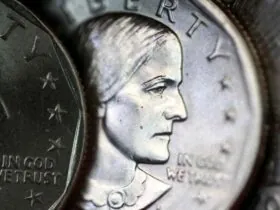The 1937 Washington Quarter, while initially just a piece of currency worth 25 cents, has risen to prominence among numismatists. Its rich history, striking design, and variations make it a sought-after collectible in the world of coin collecting. Let’s explore the allure of the 1937 quarter, its grading, values, notable mint marks, and fascinating errors.
Value of the 1937 Washington Quarter
This Article Includes
The value of a 1937 quarter can vary significantly depending on its condition, mint mark, and rarity. Below is a breakdown of the average value for the different mint marks:
| Mint Mark | Good | Fine | Extremely Fine | Uncirculated |
| No Mint Mark | $8.50 | $9.50 | $20 | $35 |
| D (Denver) | $9.00 | $12.50 | $25 | $67 |
| S (San Francisco) | $12.50 | $20 | $60 | $190 |
Grading the 1937 Quarter
Grading is a crucial step in determining the value and authenticity of any coin, including the 1937 Washington Quarter. Grading assesses aspects such as surface preservation, luster, strike quality, and overall eye appeal. The 1937 quarter’s condition ranges from basal state to mint state (MS-70). Here’s a simplified grading scale:
- Basal State (1): Heavily worn, barely recognizable.
- Good (4-6): Major details are visible but show heavy wear.
- Fine (12-15): Moderate wear with significant details intact.
- Extremely Fine (40): Light wear on the highest points; most details are sharp.
- Mint State (60-70): No wear, with brilliant luster and sharp details.
Collectors and professionals use this scale to evaluate a coin’s grade and value accurately.
The 1937 No Mint Mark Quarter

The 1937 No Mint Mark Quarter, struck in Philadelphia, is a testament to the craftsmanship of the nation’s oldest mint. Featuring George Washington’s profile on the obverse and an eagle with spread wings on the reverse, it’s an elegant and timeless design.
With a mintage of 19,696,000, the 1937 No Mint Mark Quarter is relatively abundant. However, coins in excellent condition, with minimal wear and a shiny silver finish, can fetch significantly higher prices at auctions.
The 1937-D Quarter

The Denver Mint, operational since 1906, produced 7,189,600 quarters in 1937. Known for its “D” mint mark beneath the eagle’s tail feathers, this coin embodies American pride with its detailed design and historical context.
Struck during the aftermath of the Great Depression, the 1937-D quarter is composed of 90% silver and 10% copper, weighing 6.25 grams. Collectors prize coins with full strike features, minimal wear, and notable errors. The highest recorded price for a 1937-D quarter was $7,931 for an MS-67+ specimen sold in 2013.
The 1937-S Quarter

Minted at the San Francisco Mint, the 1937-S Quarter is one of the rarest in the series, with a mintage of just over 1 million. The “S” mint mark signifies its origin at this historic mint, established during the California Gold Rush.
Collectors treasure this coin for its scarcity and craftsmanship. High-grade specimens with sharp details and vibrant patinas command premium prices. The most expensive 1937-S quarter sold for $16,800 in 2021, graded MS-67+ with exceptional preservation and striking details.
Rare Errors on the 1937 Quarter
Mint errors make coins even more desirable, and the 1937 Washington Quarter is no exception. Here are some notable errors found on this coin:
Die Cracks
Die cracks appear as raised lines on the coin due to damage or wear on the die. These can add uniqueness and value, depending on their size and location.
Cuds
Cuds are raised lumps caused by broken dies. Typically found on the rim, they range from small bumps to significant bulges and are highly sought after by collectors.
Clipped Planchets
This error occurs when a portion of the coin’s edge is missing due to an incomplete blank. The size and placement of the clip determine its value.
Off-Center Strikes
An off-center strike happens when the coin isn’t perfectly aligned during striking. These errors vary in severity and can significantly increase the coin’s value.
Double Dies

Double die errors result from the die being struck twice with misalignment, causing doubled features on the coin. Major double die errors can be extremely valuable.
Lamination Errors
These occur when impurities or defects in the metal cause parts of the coin’s surface to peel away, creating a unique texture.
Selling Your 1937 Quarter
Collectors interested in selling their 1937 quarters can explore various platforms, including online marketplaces, auction houses, and coin dealers. Ensure your coin is graded and authenticated to maximize its value.
Frequently Asked Questions
What makes the 1937 quarter valuable?
The value depends on its condition, mint mark, rarity, and any unique errors. High-grade coins and those with notable minting errors are especially valuable.
How rare is the 1937 quarter?
While over 27 million were minted, the rarity is determined by the coin’s mint mark and condition. The 1937-S is the rarest due to its low mintage.
Where is the mint mark located?
The mint mark is found on the reverse, beneath the eagle’s tail feathers. No mint mark indicates Philadelphia, “D” denotes Denver, and “S” represents San Francisco.
The 1937 Washington Quarter holds a special place in the hearts of collectors. Whether you’re drawn to its history, design, or unique errors, this coin offers an exciting journey into numismatics. Always consult experts or reliable guides to evaluate and appreciate the true worth of your collection.
Read More:
THIS IS ONLY A BLOG POST FOR INFORMATION – WE DO NOT BUY, SELL, OR APPRAISE THESE ITEMS







Leave a Reply